5.10 Handling Operating System Services and Applications
Portability Suite provides a mechanism for conversion jobs to handle Windows services (including special features for those related to Microsoft SQL Server and Microsoft Exchange Server software), Linux daemons, Solaris services, and virtualization enhancements (such as VMware Tools). In addition, when Windows HAL or kernel file replacements are required, you can view which ones were selected for update during a conversion job.
-
Section 5.10.1, Handling the Startup Mode of Services (Windows Targets)
-
Section 5.10.2, Handling Services During Live Transfer (Windows Source Workloads)
-
Section 5.10.3, Viewing Windows System Files Selected for Replacement During a Conversion
-
Section 5.10.4, Handling the Run Level of Daemons (Linux Targets)
-
Section 5.10.6, Handling Virtualization Enhancement Software
5.10.1 Handling the Startup Mode of Services (Windows Targets)
You can configure a job to modify the startup mode of selected Windows services after the conversion is complete. For example, if you don’t need a certain Windows service to continue running on a virtualized workload, you can configure your job to set that service’s target startup type to Disabled.
If you require a service to start upon another service’s request, set the startup type of the required service to Manual.
You can also configure the job to restore a service’s original startup type after the conversion is complete. For example, you might require a virus scanner to be disabled during the conversion, but its startup type to be restored after the conversion completes.
HINT:You can globally configure your startup mode preferences for selected Windows services in Portability Suite Server default options. See Target Service Defaults
in your Configuration Guide.
To configure the post-conversion startup mode of Windows services:
-
In Advanced mode: In the Conversion Job window, under the Operating System and Application Configuration section, click , then click an item in the column.
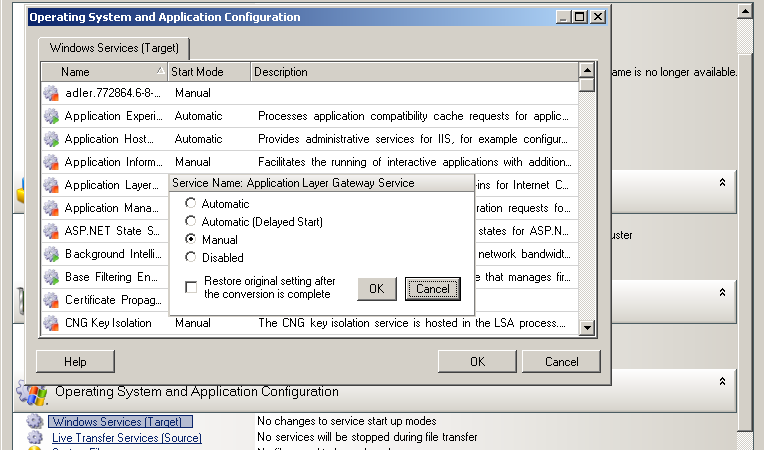
-
In Wizard mode: In the wizard’s navigation pane, click , then click an item in the column.

5.10.2 Handling Services During Live Transfer (Windows Source Workloads)
For jobs that are using the VSS File-based and VSS Block-based Live Transfer methods, Portability Suite provides a mechanism to stop selected services during the conversion. This ensures that data on your source is captured in a consistent state.
If your source workload is running Microsoft SQL Server or Microsoft Exchange Server software, you can configure your conversion job to automatically copy the database files of these servers. If you do not require the conversion to include the volume containing the databases, consider not stopping these services.
If your source workload includes I/O-intensive application services that might inhibit the ability of the file transfer process to keep up with the changes, consider stopping them during a Live Transfer conversion.
After the completion of the conversion, services that you select to stop during a Live Transfer conversion restart on the source automatically, unless you explicitly configure your conversion job to power off the source on completion.
HINT:You can globally configure your preferences for stopping selected Windows services during VSS File-based or VSS Block-based Live Transfer. See Source Service Defaults
in your Configuration Guide.
To specify which Windows services to stop during a VSS-aware Live Transfer:
-
In Advanced mode: In the Conversion Job window, under the Operating System and Application Configuration section, click . To indicate that you want SQL Server and Exchange Server database files copied during the conversion, click .
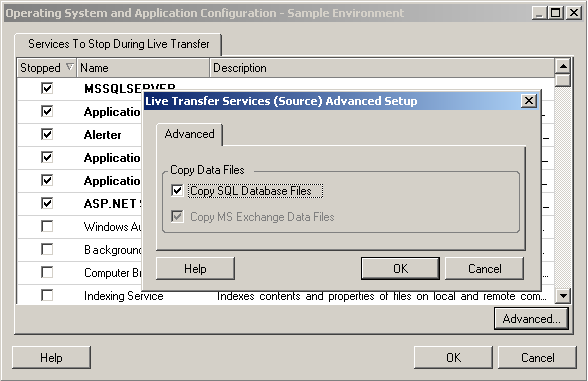
-
In Wizard mode: In the wizard’s navigation pane, click
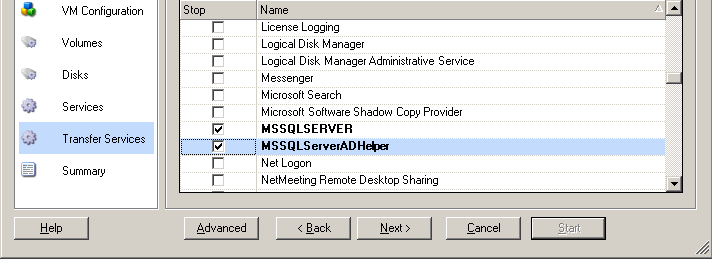
5.10.3 Viewing Windows System Files Selected for Replacement During a Conversion
When converting Windows workloads with system files (such as a HAL or kernel files) that are incompatible with the target infrastructure, Portability Suite uses an appropriate file from its library and saves a backup copy of the source file (*.bak) on the target, in the same system directory.
You can view the HAL or kernel files that Portability Suite identifies as those requiring replacement:
-
In Advanced mode: In the Conversion Job window, under the Operating System and Application Configuration section, click .
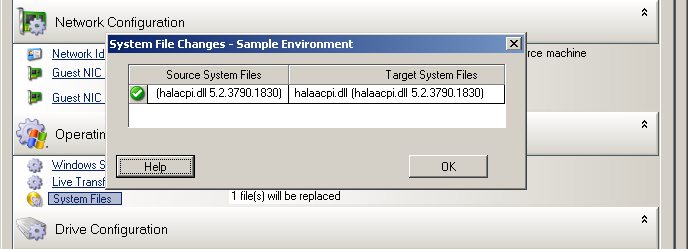
-
In Wizard mode: Not available.
The following warnings might display at the bottom of the dialog box:
If warnings appear on the screen, click (only available if warnings exist) to learn more.
See also the following Knowledge Base Articles:
5.10.4 Handling the Run Level of Daemons (Linux Targets)
You can configure a job to modify the run level of selected Linux daemons after the conversion is complete. Use the following numeric values:
|
0 |
Shutdown |
|
1 |
Single-user mode |
|
2 |
Unused (user-defined) |
|
3 |
Full multi user-mode (no GUI) |
|
4 |
Unused (user-defined) |
|
5 |
Full multi-user mode with display manager (GUI) |
|
6 |
Reboot |
To configure the post-conversion run level of Linux daemons:
-
In Advanced mode: In the Conversion Job window, under the Operating System and Application Configuration section, click , then click an item in the column.
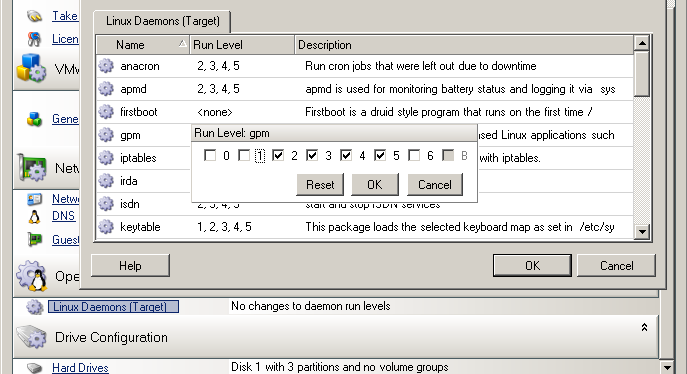
-
In Wizard mode: In the wizard’s navigation pane, click , then click an item in the column.
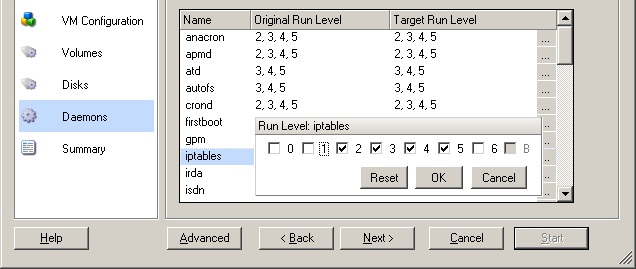
5.10.5 Handling Services on Solaris Targets
You can select Solaris services for the system to enable or disable after the conversion is complete.
To enable or disable the required Solaris services:
-
In Advanced mode: In the Conversion Job window, under the Operating System and Application Configuration section, click , then select or deselect the required service in the column.
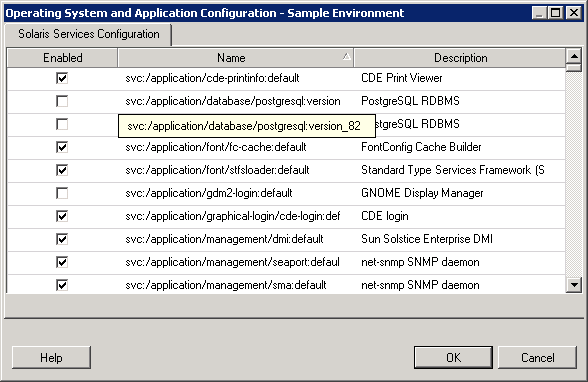
-
In Wizard mode: Not available.
5.10.6 Handling Virtualization Enhancement Software
For V2X conversions, Portability Suite provides a mechanism to automatically uninstall virtualization enhancement software, such as VMware Tools.
When converting a workload on a VMware platform that has an earlier version of VMware Tools installed, Portability Suite identifies the presence of obsolete software and adds a dedicated VMware Tools Cleanup step in the conversion job.
You must provide administrator credentials to uninstall VMware Tools. The credentials provided must match the admin-level user account that was logged in during the installation of VMware Tools.
When the earlier version is uninstalled, Portability Suite proceeds with the installation of the new version of VMware Tools.
NOTE:If you are downgrading a virtual machine that has VMware Tools installed, or if you are converting a virtual machine to another VMware target that has an older version of VMware Tools, the installation of VMware Tools during the configuration of the target will fail.
To configure a job to remove or replace VMware Tools during the conversion:
-
In Advanced mode: In the Conversion Job window, under the Operating System and Application Configuration section, click .
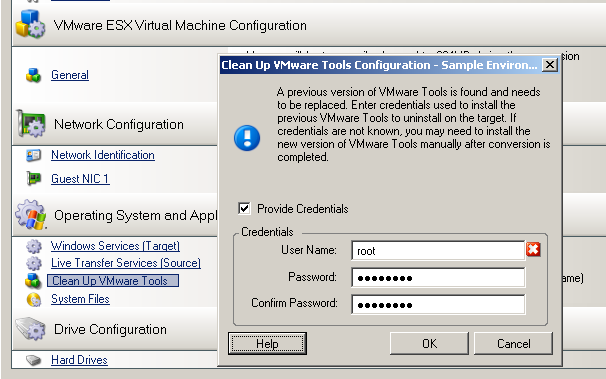
-
In Wizard mode: In the wizard’s navigation pane, click
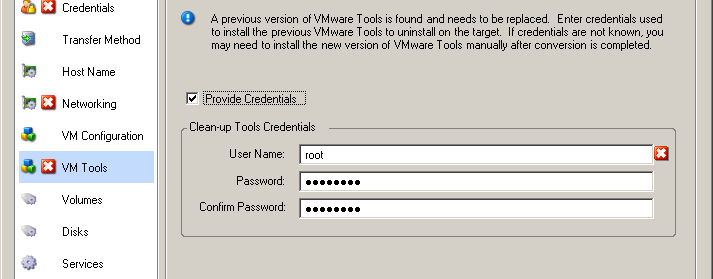
Depending on the target, Portability Suite identifies existing instances of VMware Tools and prompts to either replace or remove them, as applicable:
-
For non-VMware targets: The job configuration interface prompts you to uninstall VMware Tools. Provide the same admin-level credentials used to install the software. If the credentials are unknown, VMware Tools remains on the target machine after conversion.
-
For VMware targets: The job configuration interface prompts you to replace VMware Tools. Provide the same admin-level credentials used to install the obsolete version of VMware Tools. If the credentials are unknown, install the new version of VMware Tools manually after the conversion completes.